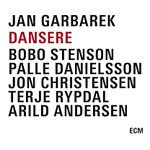|
|
 |
Dusted Reviews
Artist: Jan Garbarek Album: Dansere Label: ECM Review date: Oct. 19, 2012 |

|
|
|
 |
So much ink has been spilled over saxophonist Jan Garbarek’s unique tone and various musical associations that it would be superfluous at best, folly at worst, to travel any sort of polemic route. Love or hate the various culture and genre-defying projects in which he’s been involved over the last 40 years, from work with Keith Jarrett to his collaborations with the Hilliard Ensemble, they’ve come to represent an integral part of the ECM aesthetic. Maybe what’s so refreshing about this installment in the label’s Old and New Masters series is that these three albums were recorded at a time when Garbarek and his compatriots hadn’t quite figured out where they were going. Bassists Arild Andersen and Palle Danielsson, drummer Jon Christensen, guitarist Terje Rypdal and pianist Bobo Stenson feel their way through style, texture, timbre and timing with the excitement and energy of constant discovery.
The waves of creativity are palpable from the first notes of 1970’s Sart, as the title track clicks into focus with a five-note phrase over which the track hangs, floats and slides forward. Each long sustain from Andersen demonstrates just how stunning ECM’s engineering really was, every symbol sizzle, guitar wah and bright-then-shadowy piano cluster driving the point home until Garbarek’s tenor eases in with one of his endless swells, trailing off into the New Thing exhortation he inherited from Albert Ayler or Archie Shepp. Stenson and Rypdal finish each other’s ideas, rendering every cliché about musical telepathy true. Of course, there’s an electric Miles homage in play, which would inform Rypdal’s solo work of the period as well, and his “Lantano” is given an excellent reading here. We also find Andersen and Garbarek slowly swapping places in the stereo spectrum on “Close Enough for Jazz.” The album thrives on these experiments, and it has aged very well.
Witchi-Tai-to (1973) and Dansere (1975) demonstrate a streamlining of Garbarek’s interests, though the material he chooses is just as diverse. On the former, Carla Bley’s “A.I.R.,” originally from the Jazz Composers’ Orchestra masterpiece Escalator Over the Hill, becomes a vehicle for his airy but biting soprano, Andersen now replaced by Danielsson and Rypdal absent from the fold. We are also given the tango “Hasta Siempre” and the Jim Pepper-penned title track in a performance transformed almost beyond recognition. Most of the New Thing vibe has been sublimated, but shades of late Coltrane, especially the saxophone-driven forward motion juxtaposed with the rhythm section’s reflective meterlessness, imbue the luminescent “Bris,” from Dansere. The avant-garde does rear its head in the brief but powerful “Skrik and Hyl,” with Danielsson and Garbarek sounding as one high-register instrument.
Pervading all is Garbarek’s way of treating each note as it leads into the next and then into each phrase, and here, I can’t avoid subjectivity. As with only a few musicians, Garbarek exudes soul and spirit at every turn, no matter what he’s playing, and whenever I hear him, I get the distinct impression that music need be no more than this, that somehow, each note and gesture is complete. He could not have more sympathetic bandmates, and their extraordinary contributions, all described and contextualized in Michael Tucker’s superb liner notes, make this welcome reissue the perfect introduction to Garbarek’s soundworld in its formative stage.
By Marc Medwin
|







